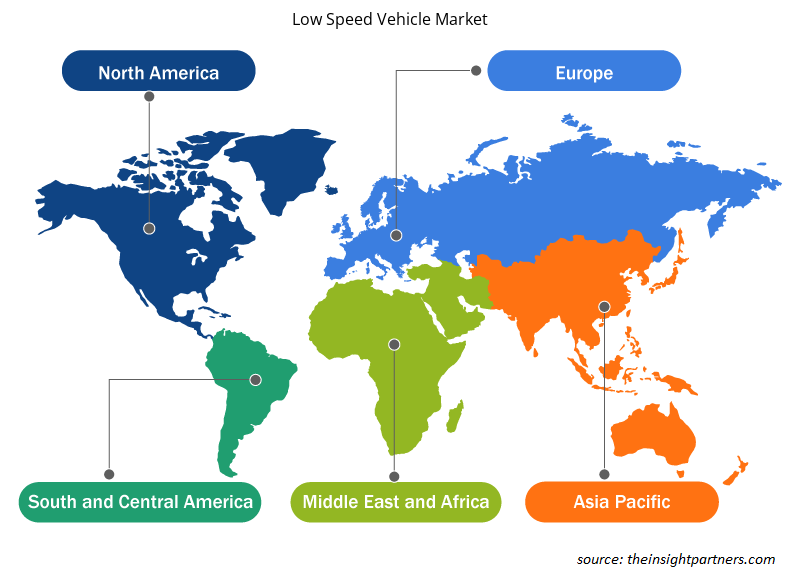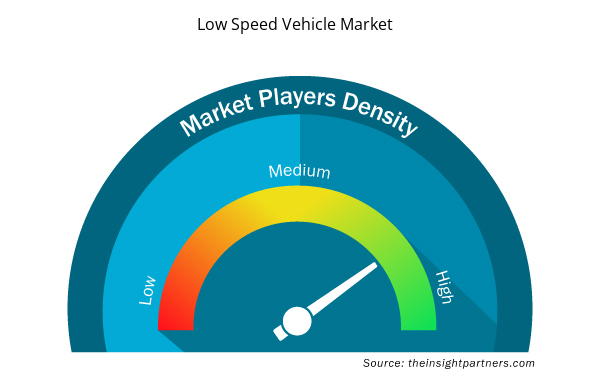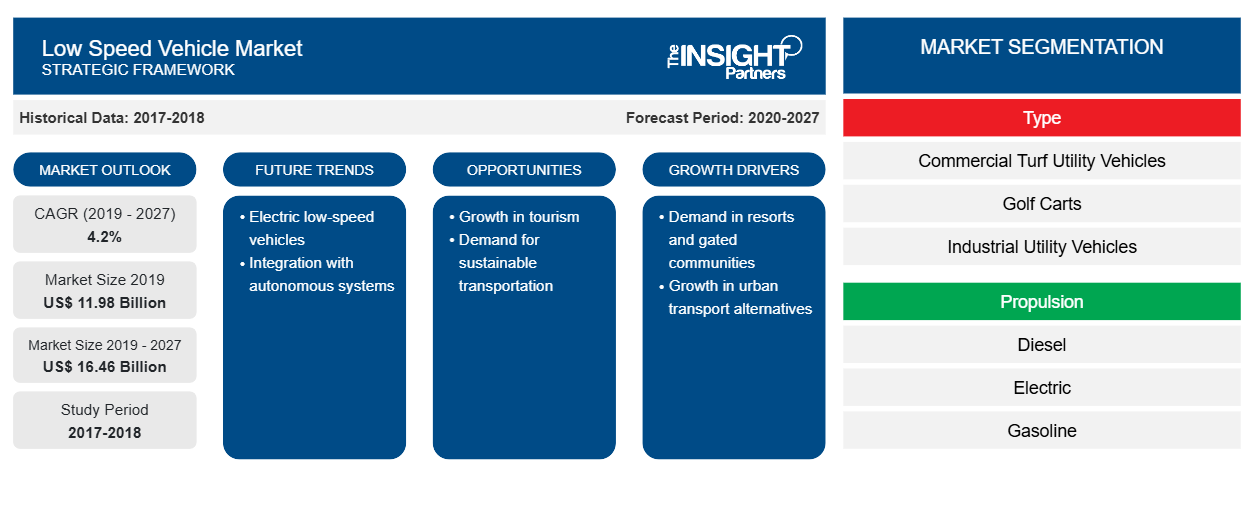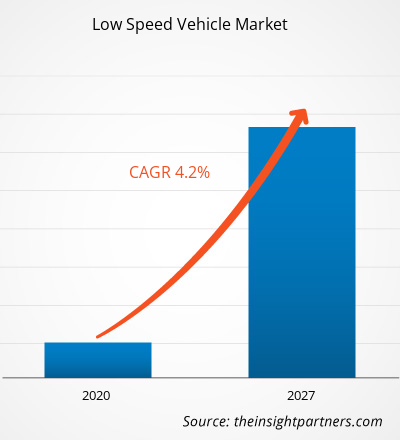El mercado de vehículos de baja velocidad se valoró en US$ 11,98 mil millones en 2019 y se espera que crezca a una CAGR del 4,2% entre 2020 y 2027 para alcanzar los US$ 16,46 mil millones en 2027.
El mercado de vehículos de baja velocidad ha experimentado un crecimiento eminente en los últimos años a nivel mundial. Las perspectivas económicas positivas, el aumento de los ingresos disponibles y el crecimiento de la población se encuentran entre los factores que impulsan la demanda de proyectos de infraestructura. Además, en relación con el alto volumen de pedidos en línea, la industria del comercio electrónico está creciendo, lo que se traduciría en una mayor propiedad de almacenes en la región. Los vehículos de baja velocidad dentro del almacén ayudan a trasladar las cajas de un lugar a otro. Los factores mencionados anteriormente juegan un papel importante en la aceleración del crecimiento del mercado de vehículos de baja velocidad . La APAC tuvo la mayor participación de mercado en 2019 y se prevé que sea la región de más rápido crecimiento en el mercado de vehículos de baja velocidad. América del Norte y Europa son la segunda y tercera región más grande en el mercado de baja velocidad.
El brote de coronavirus comenzó en Wuhan (China) durante diciembre de 2019. Se ha extendido a un ritmo rápido por todo el mundo y algunos de los países más afectados incluyen China, Italia, Irán, España, República de Corea, Francia, Alemania y los EE. UU. El brote de COVID-19 y sus efectos resultantes, como cierres fronterizos, cierres y prohibiciones de viaje, han comenzado a afectar a las empresas de varias industrias. Se anticipa que el mercado de vehículos de baja velocidad tendrá un impacto medio debido a las interrupciones en las cadenas de suministro globales. Las empresas que operan en este mercado verán una caída en las ventas generales en el corto plazo (3-6 meses), sin embargo, el mercado experimentará un crecimiento constante en los próximos años.
Personalice este informe según sus necesidades
Obtendrá personalización en cualquier informe, sin cargo, incluidas partes de este informe o análisis a nivel de país, paquete de datos de Excel, así como también grandes ofertas y descuentos para empresas emergentes y universidades.
- Obtenga las principales tendencias clave del mercado de este informe.Esta muestra GRATUITA incluirá análisis de datos, desde tendencias del mercado hasta estimaciones y pronósticos.
Perspectivas del mercado
Aumentan las iniciativas gubernamentales para fomentar el transporte sostenible
La Unión Europea, China, Japón, Canadá, India y Corea del Sur son algunas de las principales geografías donde los gobiernos están tomando medidas proactivas para aumentar la adopción de vehículos eléctricos. Por ejemplo, en la Unión Europea, se han logrado mejoras significativas en los estándares de ahorro de combustible para los vehículos existentes. Se formuló una "Directiva de vehículos limpios" para la adquisición de autobuses eléctricos por parte del sector gubernamental. También se está formando otra directiva llamada "Directiva de edificios de rendimiento energético", que establece estándares mínimos para la instalación de infraestructura de carga en los edificios.
Perspectivas sobre propulsión
El mercado de vehículos de baja velocidad, por propulsión, se segmenta en diésel, eléctrico y gasolina. El segmento impulsado por combustible capturó una participación dominante en el mercado mundial de vehículos de baja velocidad. Ha habido una tendencia creciente de vehículos de alta potencia que son capaces de moverse en las carreteras permitidas y pueden utilizarse como vehículos utilitarios y transporte de personal. Por lo tanto, durante el período de pronóstico, se proyecta que los vehículos eléctricos de baja velocidad tengan un crecimiento significativo, junto con los vehículos de baja velocidad de alta potencia que, a su vez, se espera que eventualmente impulsen el mercado de vehículos de baja velocidad.
Tipo de información
El mercado de vehículos de baja velocidad, por tipo, se segmenta en vehículos utilitarios comerciales, carros de golf, vehículos utilitarios industriales y transporte de personal. El segmento de carros de golf capturó una participación dominante en el mercado global de vehículos de baja velocidad. Varias comunidades en los Estados Unidos dependen en gran medida de vehículos eléctricos de baja velocidad para desplazarse. Para las personas mayores, caminar a veces puede ser difícil, mientras que conducir un automóvil puede ser una carga e incluso inseguro.
Las empresas suelen adoptar iniciativas de mercado y nuevas estrategias de desarrollo para expandir su presencia en todo el mundo y satisfacer la creciente demanda. Estas estrategias se observan principalmente en América del Norte y Europa. Los actores presentes en el mercado de vehículos de baja velocidad adoptan la estrategia de expansión e inversión en investigación y desarrollo para ampliar la base de clientes en todo el mundo, lo que también les permite mantener su marca a nivel mundial.
Perspectivas regionales del mercado de vehículos de baja velocidad
Los analistas de Insight Partners explicaron en detalle las tendencias y los factores regionales que influyen en el mercado de vehículos de baja velocidad durante el período de pronóstico. Esta sección también analiza los segmentos y la geografía del mercado de vehículos de baja velocidad en América del Norte, Europa, Asia Pacífico, Oriente Medio y África, y América del Sur y Central.

- Obtenga los datos regionales específicos para el mercado de vehículos de baja velocidad
Alcance del informe sobre el mercado de vehículos de baja velocidad
| Atributo del informe | Detalles |
|---|---|
| Tamaño del mercado en 2019 | US$ 11,98 mil millones |
| Tamaño del mercado en 2027 | US$ 16.46 mil millones |
| CAGR global (2019-2027) | 4,2% |
| Datos históricos | 2017-2018 |
| Período de pronóstico | 2020-2027 |
| Segmentos cubiertos | Por tipo
|
| Regiones y países cubiertos | América del norte
|
| Líderes del mercado y perfiles de empresas clave |
|
Densidad de actores del mercado de vehículos de baja velocidad: comprensión de su impacto en la dinámica empresarial
El mercado de vehículos de baja velocidad está creciendo rápidamente, impulsado por la creciente demanda de los usuarios finales debido a factores como la evolución de las preferencias de los consumidores, los avances tecnológicos y una mayor conciencia de los beneficios del producto. A medida que aumenta la demanda, las empresas amplían sus ofertas, innovan para satisfacer las necesidades de los consumidores y aprovechan las tendencias emergentes, lo que impulsa aún más el crecimiento del mercado.
La densidad de actores del mercado se refiere a la distribución de las empresas o firmas que operan dentro de un mercado o industria en particular. Indica cuántos competidores (actores del mercado) están presentes en un espacio de mercado determinado en relación con su tamaño o valor total de mercado.
Las principales empresas que operan en el mercado de vehículos de baja velocidad son:
- Vehículo eléctrico Bintelli
- Club de coches, LLC
- Coche de crucero, Inc.,
- Deere & Company
- Compañía HDK, Ltd.
Descargo de responsabilidad : Las empresas enumeradas anteriormente no están clasificadas en ningún orden particular.

- Obtenga una descripción general de los principales actores clave del mercado de vehículos de baja velocidad
Mercado de vehículos de baja velocidad: por tipo
- Vehículos utilitarios comerciales para césped
- Carritos de golf
- Vehículos utilitarios industriales
- Transporte de personal
Mercado de vehículos de baja velocidad – Por propulsión
- Diesel
- Eléctrico
- Gasolina
Mercado de vehículos de baja velocidad: por geografía
América del norte
- A NOSOTROS
- Canadá
- México
Europa
- Francia
- Alemania
- Italia
- Reino Unido
- Rusia
- Resto de Europa
Asia Pacífico
- Porcelana
- India
- Australia
- Corea del Sur
- Japón
- Resto de Asia Pacífico
Oriente Medio y África
- Sudáfrica
- Arabia Saudita
- Emiratos Árabes Unidos
- Resto de Oriente Medio y África
Sudamerica
- Brasil
- Argentina
- Resto de Sudamérica
Perfiles de empresas
- Vehículo eléctrico Bintelli
- Club de coches, LLC
- Coche de crucero, Inc.,
- Deere & Company
- Compañía HDK, Ltd.
- Vehículos eléctricos de moto
- Compañía Polaris Inc.
- Vehículos especializados Textron Inc.
- La Compañía Toro
- Compañía de carros de golf Yamaha
- Análisis histórico (2 años), año base, pronóstico (7 años) con CAGR
- Análisis PEST y FODA
- Tamaño del mercado Valor/volumen: global, regional, nacional
- Industria y panorama competitivo
- Conjunto de datos de Excel



Report Coverage
Revenue forecast, Company Analysis, Industry landscape, Growth factors, and Trends

Segment Covered
This text is related
to segments covered.

Regional Scope
North America, Europe, Asia Pacific, Middle East & Africa, South & Central America

Country Scope
This text is related
to country scope.
Preguntas frecuentes
In 2019, the golf carts segment led the low speed vehicle market by type and it is anticipated to continue its dominance during the forecast period of 2020 to 2027. The golf carts are available in different types, such as gas and electric golf carts. Several communities in countries like United States depend heavily on low-speed electric vehicles to get around.
Over the past few years, electric mobility has been growing at an unprecedented rate across major economies. Due to increasing concerns regarding environmental protection and favorable government policies, the sales figures of electric vehicles has seen an impressive surge in the past decade. Better fuel economy standards and zero & low emission vehicle incentives are some of the measures which are taken to lower the carbon emission level in the environment. This factor is anticipated to provide growth opportunities for the low speed vehicle market during the forecast period of 2020 to 2027.
The rising smart mobility service adoption, rapid urbanization, and increasing construction industry as well as government incentives to encourage sales of electric vehicles and high awareness regarding nonconventional fuel-driven vehicles in Asia are among the major factors boosting the low speed vehicle market growth in this region.
Trends and growth analysis reports related to Automotive and Transportation : READ MORE..
The List of Companies - Low Speed Vehicle Market
- Bintelli Electric Vehicle
- Club Car, LLC
- Cruise Car, Inc.,
- Deere & Company
- HDK Co., Ltd.
- Moto Electric Vehicles
- Polaris Inc.
- Textron Specialized Vehicles Inc.
- The Toro Company
- Yamaha Golf-Car Company
The Insight Partners performs research in 4 major stages: Data Collection & Secondary Research, Primary Research, Data Analysis and Data Triangulation & Final Review.
- Data Collection and Secondary Research:
As a market research and consulting firm operating from a decade, we have published and advised several client across the globe. First step for any study will start with an assessment of currently available data and insights from existing reports. Further, historical and current market information is collected from Investor Presentations, Annual Reports, SEC Filings, etc., and other information related to company’s performance and market positioning are gathered from Paid Databases (Factiva, Hoovers, and Reuters) and various other publications available in public domain.
Several associations trade associates, technical forums, institutes, societies and organization are accessed to gain technical as well as market related insights through their publications such as research papers, blogs and press releases related to the studies are referred to get cues about the market. Further, white papers, journals, magazines, and other news articles published in last 3 years are scrutinized and analyzed to understand the current market trends.
- Primary Research:
The primarily interview analysis comprise of data obtained from industry participants interview and answers to survey questions gathered by in-house primary team.
For primary research, interviews are conducted with industry experts/CEOs/Marketing Managers/VPs/Subject Matter Experts from both demand and supply side to get a 360-degree view of the market. The primary team conducts several interviews based on the complexity of the markets to understand the various market trends and dynamics which makes research more credible and precise.
A typical research interview fulfils the following functions:
- Provides first-hand information on the market size, market trends, growth trends, competitive landscape, and outlook
- Validates and strengthens in-house secondary research findings
- Develops the analysis team’s expertise and market understanding
Primary research involves email interactions and telephone interviews for each market, category, segment, and sub-segment across geographies. The participants who typically take part in such a process include, but are not limited to:
- Industry participants: VPs, business development managers, market intelligence managers and national sales managers
- Outside experts: Valuation experts, research analysts and key opinion leaders specializing in the electronics and semiconductor industry.
Below is the breakup of our primary respondents by company, designation, and region:

Once we receive the confirmation from primary research sources or primary respondents, we finalize the base year market estimation and forecast the data as per the macroeconomic and microeconomic factors assessed during data collection.
- Data Analysis:
Once data is validated through both secondary as well as primary respondents, we finalize the market estimations by hypothesis formulation and factor analysis at regional and country level.
- Macro-Economic Factor Analysis:
We analyse macroeconomic indicators such the gross domestic product (GDP), increase in the demand for goods and services across industries, technological advancement, regional economic growth, governmental policies, the influence of COVID-19, PEST analysis, and other aspects. This analysis aids in setting benchmarks for various nations/regions and approximating market splits. Additionally, the general trend of the aforementioned components aid in determining the market's development possibilities.
- Country Level Data:
Various factors that are especially aligned to the country are taken into account to determine the market size for a certain area and country, including the presence of vendors, such as headquarters and offices, the country's GDP, demand patterns, and industry growth. To comprehend the market dynamics for the nation, a number of growth variables, inhibitors, application areas, and current market trends are researched. The aforementioned elements aid in determining the country's overall market's growth potential.
- Company Profile:
The “Table of Contents” is formulated by listing and analyzing more than 25 - 30 companies operating in the market ecosystem across geographies. However, we profile only 10 companies as a standard practice in our syndicate reports. These 10 companies comprise leading, emerging, and regional players. Nonetheless, our analysis is not restricted to the 10 listed companies, we also analyze other companies present in the market to develop a holistic view and understand the prevailing trends. The “Company Profiles” section in the report covers key facts, business description, products & services, financial information, SWOT analysis, and key developments. The financial information presented is extracted from the annual reports and official documents of the publicly listed companies. Upon collecting the information for the sections of respective companies, we verify them via various primary sources and then compile the data in respective company profiles. The company level information helps us in deriving the base number as well as in forecasting the market size.
- Developing Base Number:
Aggregation of sales statistics (2020-2022) and macro-economic factor, and other secondary and primary research insights are utilized to arrive at base number and related market shares for 2022. The data gaps are identified in this step and relevant market data is analyzed, collected from paid primary interviews or databases. On finalizing the base year market size, forecasts are developed on the basis of macro-economic, industry and market growth factors and company level analysis.
- Data Triangulation and Final Review:
The market findings and base year market size calculations are validated from supply as well as demand side. Demand side validations are based on macro-economic factor analysis and benchmarks for respective regions and countries. In case of supply side validations, revenues of major companies are estimated (in case not available) based on industry benchmark, approximate number of employees, product portfolio, and primary interviews revenues are gathered. Further revenue from target product/service segment is assessed to avoid overshooting of market statistics. In case of heavy deviations between supply and demand side values, all thes steps are repeated to achieve synchronization.
We follow an iterative model, wherein we share our research findings with Subject Matter Experts (SME’s) and Key Opinion Leaders (KOLs) until consensus view of the market is not formulated – this model negates any drastic deviation in the opinions of experts. Only validated and universally acceptable research findings are quoted in our reports.
We have important check points that we use to validate our research findings – which we call – data triangulation, where we validate the information, we generate from secondary sources with primary interviews and then we re-validate with our internal data bases and Subject matter experts. This comprehensive model enables us to deliver high quality, reliable data in shortest possible time.


 Obtenga una muestra gratuita de este informe
Obtenga una muestra gratuita de este informe